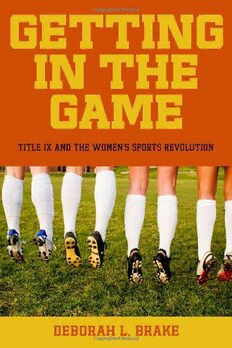
Getting in the Game: Title IX and the Women's Sports Revolution (Critical America (New York University Hardcover)) PDF
298 Pages·2010·1.765 MB·English
Most books are stored in the elastic cloud where traffic is expensive. For this reason, we have a limit on daily download.
Preview Getting in the Game: Title IX and the Women's Sports Revolution (Critical America (New York University Hardcover))
Description:
Title IX, a landmark federal statute enacted in 1972 to prohibit sex discrimination in education, has worked its way into American culture as few other laws have. It is an iconic law, the subject of web blogs and T-shirt slogans, and is widely credited with opening the doors to the massive numbers of girls and women now participating in competitive sports. Yet few people fully understand the law’s requirements, or the extent to which it has succeeded in challenging the gender norms that have circumscribed women’s opportunities as athletes and their place in society more generally.In this first legal analysis of Title IX, Deborah L. Brake assesses the statute’s successes and failures. While the statute has created tremendous gains for female athletes, not only raising the visibility and cultural acceptance of women in sports, but also creating social bonds for women, positive body images, and leadership roles, the disparities in funding between men’s and women’s sports have remained remarkably resilient. At the same time, female athletes continue to receive less prestige and support than their male counterparts, which in turn filters into the arena of professional sports. Brake provides a richer understanding and appreciation of what Title IX has accomplished, while taking a critical look at the places where the law has fallen short. A unique contribution to the literature on Title IX, Getting in the Game fully explores the theory, policy choices, successes, and limitations of this historic law.
See more
The list of books you might like
Most books are stored in the elastic cloud where traffic is expensive. For this reason, we have a limit on daily download.
